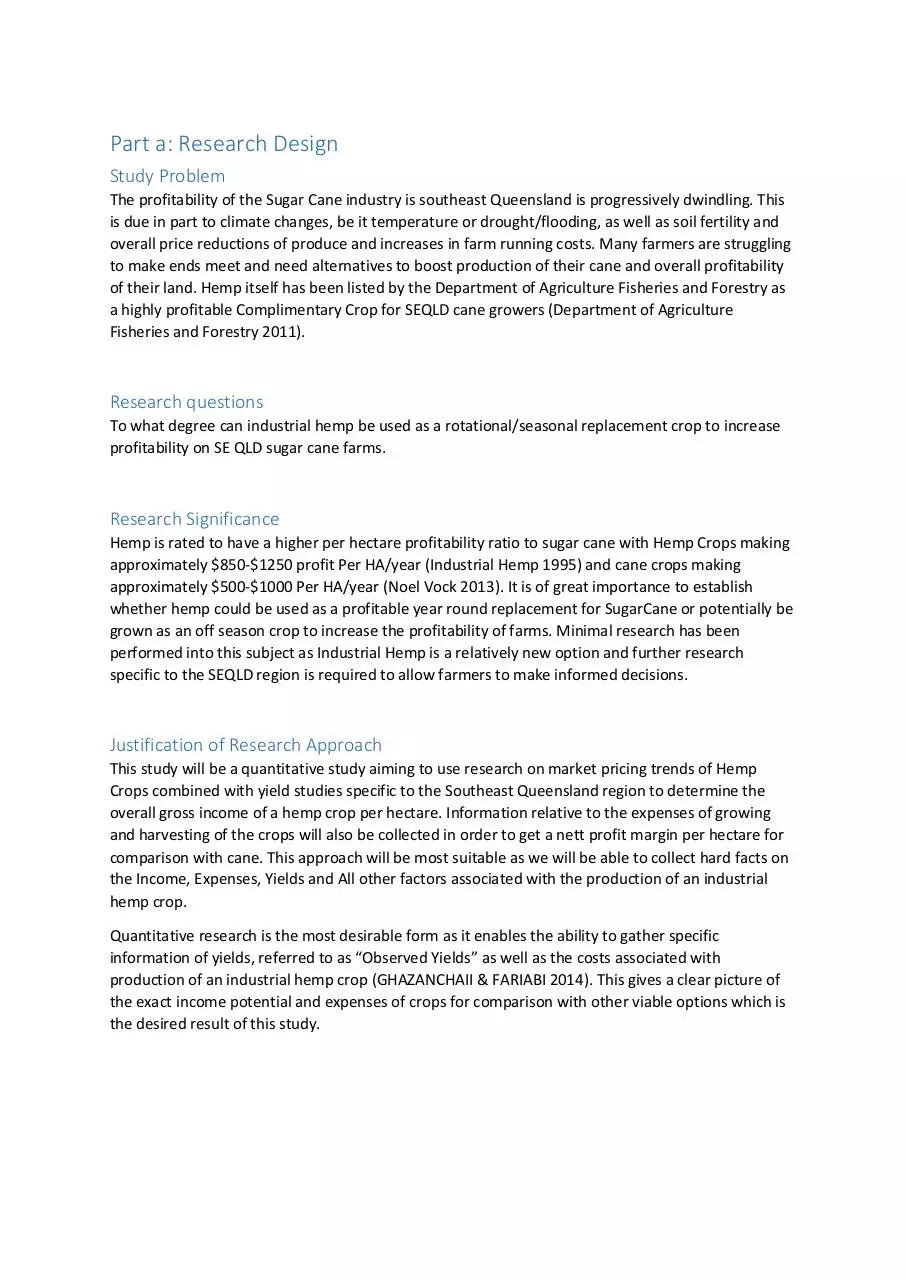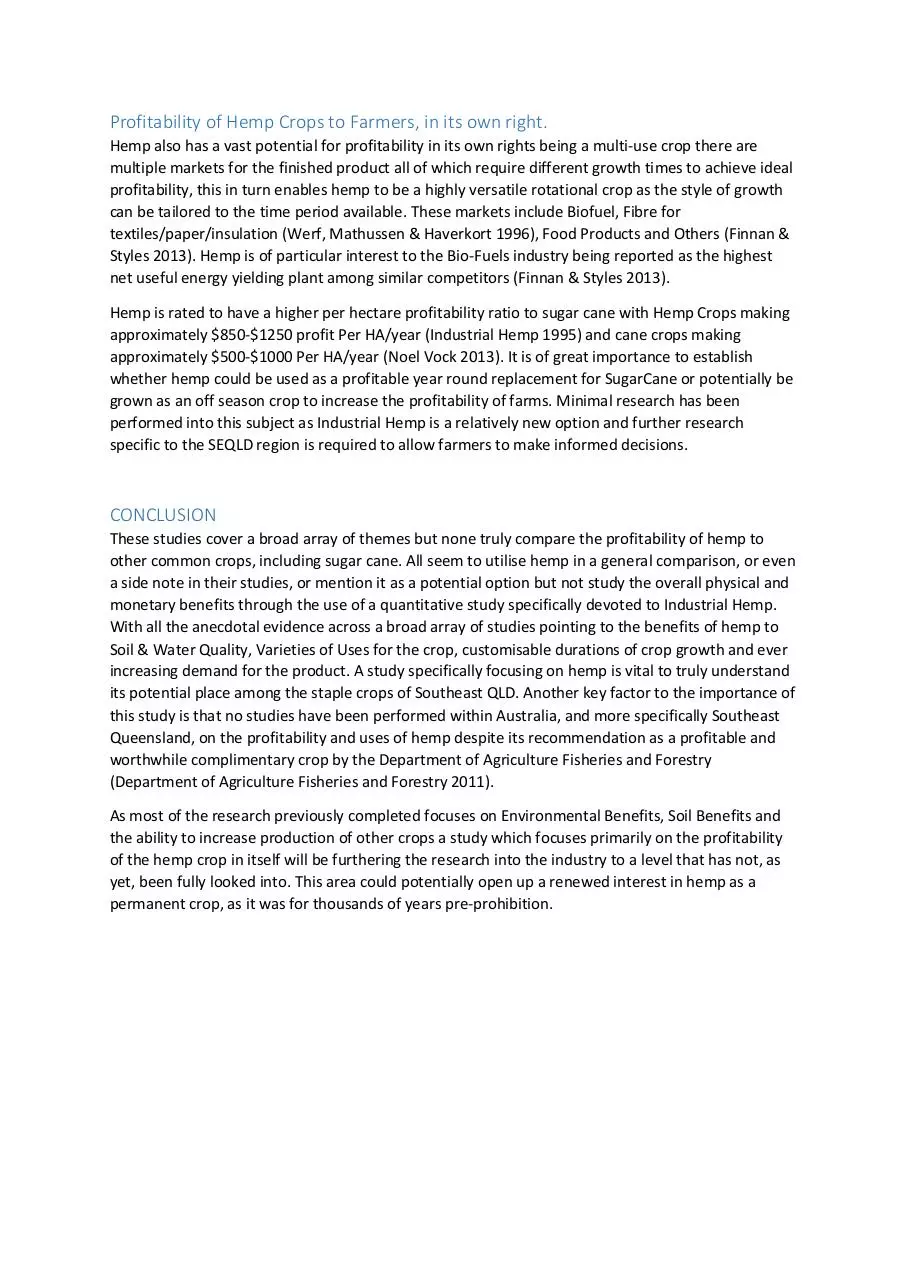MYWORK (PDF)
File information
Author: Luke Matthew. Bull
This PDF 1.5 document has been generated by Microsoft® Word 2013, and has been sent on pdf-archive.com on 16/12/2016 at 03:51, from IP address 101.177.x.x.
The current document download page has been viewed 499 times.
File size: 513.3 KB (6 pages).
Privacy: public file





File preview
Part a: Research Design
Study Problem
The profitability of the Sugar Cane industry is southeast Queensland is progressively dwindling. This
is due in part to climate changes, be it temperature or drought/flooding, as well as soil fertility and
overall price reductions of produce and increases in farm running costs. Many farmers are struggling
to make ends meet and need alternatives to boost production of their cane and overall profitability
of their land. Hemp itself has been listed by the Department of Agriculture Fisheries and Forestry as
a highly profitable Complimentary Crop for SEQLD cane growers (Department of Agriculture
Fisheries and Forestry 2011).
Research questions
To what degree can industrial hemp be used as a rotational/seasonal replacement crop to increase
profitability on SE QLD sugar cane farms.
Research Significance
Hemp is rated to have a higher per hectare profitability ratio to sugar cane with Hemp Crops making
approximately $850-$1250 profit Per HA/year (Industrial Hemp 1995) and cane crops making
approximately $500-$1000 Per HA/year (Noel Vock 2013). It is of great importance to establish
whether hemp could be used as a profitable year round replacement for SugarCane or potentially be
grown as an off season crop to increase the profitability of farms. Minimal research has been
performed into this subject as Industrial Hemp is a relatively new option and further research
specific to the SEQLD region is required to allow farmers to make informed decisions.
Justification of Research Approach
This study will be a quantitative study aiming to use research on market pricing trends of Hemp
Crops combined with yield studies specific to the Southeast Queensland region to determine the
overall gross income of a hemp crop per hectare. Information relative to the expenses of growing
and harvesting of the crops will also be collected in order to get a nett profit margin per hectare for
comparison with cane. This approach will be most suitable as we will be able to collect hard facts on
the Income, Expenses, Yields and All other factors associated with the production of an industrial
hemp crop.
Quantitative research is the most desirable form as it enables the ability to gather specific
information of yields, referred to as “Observed Yields” as well as the costs associated with
production of an industrial hemp crop (GHAZANCHAII & FARIABI 2014). This gives a clear picture of
the exact income potential and expenses of crops for comparison with other viable options which is
the desired result of this study.
Part B: Literature Review
Framework
The framework of this literature review are the following issues: Effects of hemp on Soil and Water
Quality, Ability for Hemp crops to increase profitability of other crops and the ability of hemp to be a
profitable crop in its own right.
Introduction
Many studies have been performed on the effects of Hemp on Soil quality, Water Quality,
Profitability of Hemp crops and the ability for hemp to be used in rotation with other more dominant
crops in recent years with quite consistent results among each. However none of these studies have
been conducted within Australia or areas with suitably similar climates, or dominant crop bases.
Predominantly use of hemp as a rotational crop has been researched in areas focusing on wheat and
other similar products and generally Hemp was not the key focal point of these studies.
Benefits of Hemp to Soil and Water Quality.
Hemp has been proven to improve soil structure substantially when used as a break crop (Finnan &
Styles 2013) which when used in rotation with other common crops such as wheat can help to
increase yields by upto 20% (Kirkegaard et al. 2008). Hemp has also been found to work as an
effective control method for soil nematodes. This in itself is believed to be of more vital importance
to the added profitability of crops than the effects on soil structure. These benefits need to be
examined in greater detail within the cane industry to establish whether the benefits are applicable
to cane crops.
If heavy metal contamination occurs to the lands such as those within the vicinity of mines, or
damaged groundwater supplies hemp is a highly effective Phytoremediation plant and can absorb
large amounts of heavy metals from the soil (Linger et al. 2002), while still producing a profit for the
farmer during the process, unlike food and textile only crops. This gives the potential for farmers to
reclaim ex mining land for agricultural purposes and potentially even move back to growth of food
products on this land after suitable combinations of phytoremediation and other remediation
methods are performed with minimised outlay of remediation processes.
Profitability of Hemp Crops to Farmers, helping increase yields of other crops
These benefits to other crops grown on the land are one way in which a hemp crop can help to
increase profitability of a farm indirectly through increasing the overall production rates of the usual
crops on site. Further research into whether this increase in production also applies to sugar cane
would be a topic of vital importance for SEQLD Canefarmers. Through the benefits of increased
organic matter in soil content through dropped leaves, reduced soil erosion, increase permeability
and various other physical, chemical and biological benefits (Zegada-Lizarazu & Monti 2011)
rotational crops, hemp included, are a logical way to save money on soil conditioning and pest
control and to make money during the non-growing season.
Profitability of Hemp Crops to Farmers, in its own right.
Hemp also has a vast potential for profitability in its own rights being a multi-use crop there are
multiple markets for the finished product all of which require different growth times to achieve ideal
profitability, this in turn enables hemp to be a highly versatile rotational crop as the style of growth
can be tailored to the time period available. These markets include Biofuel, Fibre for
textiles/paper/insulation (Werf, Mathussen & Haverkort 1996), Food Products and Others (Finnan &
Styles 2013). Hemp is of particular interest to the Bio-Fuels industry being reported as the highest
net useful energy yielding plant among similar competitors (Finnan & Styles 2013).
Hemp is rated to have a higher per hectare profitability ratio to sugar cane with Hemp Crops making
approximately $850-$1250 profit Per HA/year (Industrial Hemp 1995) and cane crops making
approximately $500-$1000 Per HA/year (Noel Vock 2013). It is of great importance to establish
whether hemp could be used as a profitable year round replacement for SugarCane or potentially be
grown as an off season crop to increase the profitability of farms. Minimal research has been
performed into this subject as Industrial Hemp is a relatively new option and further research
specific to the SEQLD region is required to allow farmers to make informed decisions.
CONCLUSION
These studies cover a broad array of themes but none truly compare the profitability of hemp to
other common crops, including sugar cane. All seem to utilise hemp in a general comparison, or even
a side note in their studies, or mention it as a potential option but not study the overall physical and
monetary benefits through the use of a quantitative study specifically devoted to Industrial Hemp.
With all the anecdotal evidence across a broad array of studies pointing to the benefits of hemp to
Soil & Water Quality, Varieties of Uses for the crop, customisable durations of crop growth and ever
increasing demand for the product. A study specifically focusing on hemp is vital to truly understand
its potential place among the staple crops of Southeast QLD. Another key factor to the importance of
this study is that no studies have been performed within Australia, and more specifically Southeast
Queensland, on the profitability and uses of hemp despite its recommendation as a profitable and
worthwhile complimentary crop by the Department of Agriculture Fisheries and Forestry
(Department of Agriculture Fisheries and Forestry 2011).
As most of the research previously completed focuses on Environmental Benefits, Soil Benefits and
the ability to increase production of other crops a study which focuses primarily on the profitability
of the hemp crop in itself will be furthering the research into the industry to a level that has not, as
yet, been fully looked into. This area could potentially open up a renewed interest in hemp as a
permanent crop, as it was for thousands of years pre-prohibition.
Part C: Research Proposal
Research Design
This study will be a quantitative study measuring a variety of data related to the Growing of
Industrial Hemp, this will fall under the experimental category. This is the ideal method of study as
we are seeking to establish the profitability of Industrial Hemp for growers and as such will want the
study to be as controlled as possible across all sites. Furthermore detailed information will need to
be kept for cross comparison of starting conditions of each site, conditions during the study and
conditions after the study to determine the effects of the Hemp crop on the soil, water, and
rotational crop growth rates in a variety of conditions.
Participants and Research Setting
Participants in this study would be cane farmers within the south-east Queensland region. Ideally
they would be farmers looking for a rotational crop to boost the profitability of their farms. Of these
participants there would need to be a variety of farm locations that feature a diverse array of local
climate, soil and water variations. Ideally at least 5 hectares minimum per farm would be required to
use in this study and approximately 50 participants total to be able to get a decent average of all
data. To contact these participants utilising the various Canegrower associations of queensland as a
base to contact their members would be applicable. Supply/funding of seed and all testing
equipment by the scientists performing the study would help to convince farmers to sign on.
The research setting required would be varied from site to site with a combination of each of the
following features required to get a true understanding of how Hemp can benefit farmers in carious
conditions.
-
Low, Medium and High Altitudes.
Low, Medium and High water availability.
Sodic and Non-Sodic soils.
Soils which are predominantly Clay, Loam and Sandy and mixtures in between.
Both fertilised and non-fertilised crops.
Data Collection & Analysis
Data Collection
Direct measurements of data such as Soil Conditions, Water Content, Rainfall, total crop yields
would be taken by scientists. This would have to be in conjunction with the farmers and shipping
companies in order to get weights of finished product. Research on market prices over the period of
a year for hemp biomass would be used in the calculation of profits. Expenses such as seed
purchase, irrigation, machinery, labor and processing would also need to be collected this would be
logged by the participant and checked by one of the staff performing the study.
Data Analysis
Data would be analysed in three lots. An initial thematic analysis would be conducted to gauge the
potential direct profitability of the Hemp in various conditions by comparing income and expenses as
well as an overall average. A secondary thematic analysis would be conducted on the soil and water
condition prior to the growing of the hemp crop and after the harvest to determine the effectiveness
of hemp as a soil and water conditioner. Finally a comparison would be made between the overall
yield pre-hemp and post-hemp to determine if there is any notable variances.
Ethical Considerations
Being a study of primarily agricultural techniques there are minimal psychological or other risks to
the participants in the study. All participants will have their private information and the fact they are
participating in the study kept confidential to avoid potential judgment from any people who may
deem a hemp crop to be the same as illicit cannabis production. Any financials that need to be
submitted in order to work out the study will be coded with a project code and this code will not
include the location, or name, or any other identifying features of the farm/farmer. Upon
completion of the study all relevant data relating to the specific location will be stored on a
confidential file in a non-networked computer and only those agreed to by the farmer(s) as able to
access the data will be allowed access.
The aims of the study are very clear and will be directly conveyed to the farmers prior to their
acceptance of participation in the study. A detailed written outline of what the study is aiming to
test as well as the requirements of the farmers and potential costs associated will be clearly
explained. Unless this information is clearly understood and signed of on by the participant the study
will not go ahead at that site.
All information that the study requires the farmers to log will be outlined upfront and one of the
study officials will help the farmer with developing suitable processes and with how to fill the
paperwork out effectively, primarily where possible automated machinery will be used to take
measurements and readings to avoid any potential human error.
Department of Agriculture Fisheries and Forestry 2011, Complimentary Crops in the Sugarcane
Industry, viewed 15 May 2015, <https://www.daf.qld.gov.au/plants/field-crops-andpastures/sugar/complementary-crops>.
Finnan, J & Styles, D 2013, 'Hemp: A more sustainable annual energy crop for climate and energy
policy', Energy Policy, vol. 58, no. 0, pp. 152-62.
GHAZANCHAII, R & FARIABI, A 2014, 'Evaluation of Qualitative, Quantitative Land Suitability for
Major Crops in Dezful Region', International Journal of Soil Science, vol. 9, pp. 120-32.
Industrial Hemp, C 1995, Industrial hemp : the potential for an industrial hemp industry in Australia :
13-14 December 1995, held at the Hilton on the Park, Melbourne / jointly convened by the Australian
Institute of Agricultural Science and the Rural Industries Research and Development Corporation ;
editor Simon Field, AIAS occasional publication ; no. 92., Australian Institute of Agricultural Science,
Carlton, Vic.
Kirkegaard, J, Christen, O, Krupinsky, J & Layzell, D 2008, 'Break crop benefits in temperate wheat
production', Field Crops Research, vol. 107, no. 3, pp. 185-95.
Linger, P, Müssig, J, Fischer, H & Kobert, J 2002, 'Industrial hemp (Cannabis sativa L.) growing on
heavy metal contaminated soil: fibre quality and phytoremediation potential', Industrial Crops and
Products, vol. 16, no. 1, pp. 33-42.
Noel Vock 2013, Sugar Cane Advisors Information Kit, vol. 1, Sugar Research Australia, Indooroopilly
QLD.
Werf, HVD, Mathussen, EWJM & Haverkort, AJ 1996, 'The potential of hemp (Cannabis sativa L.) for
sustainable fibre production: a crop physiological appraisal', Annals of Applied Biology, vol. 129, no.
1, pp. 109-23.
Zegada-Lizarazu, W & Monti, A 2011, 'Energy crops in rotation. A review', Biomass and Bioenergy,
vol. 35, no. 1, pp. 12-25.
Download MYWORK
MYWORK.pdf (PDF, 513.3 KB)
Download PDF
Share this file on social networks
Link to this page
Permanent link
Use the permanent link to the download page to share your document on Facebook, Twitter, LinkedIn, or directly with a contact by e-Mail, Messenger, Whatsapp, Line..
Short link
Use the short link to share your document on Twitter or by text message (SMS)
HTML Code
Copy the following HTML code to share your document on a Website or Blog
QR Code to this page

This file has been shared publicly by a user of PDF Archive.
Document ID: 0000522893.